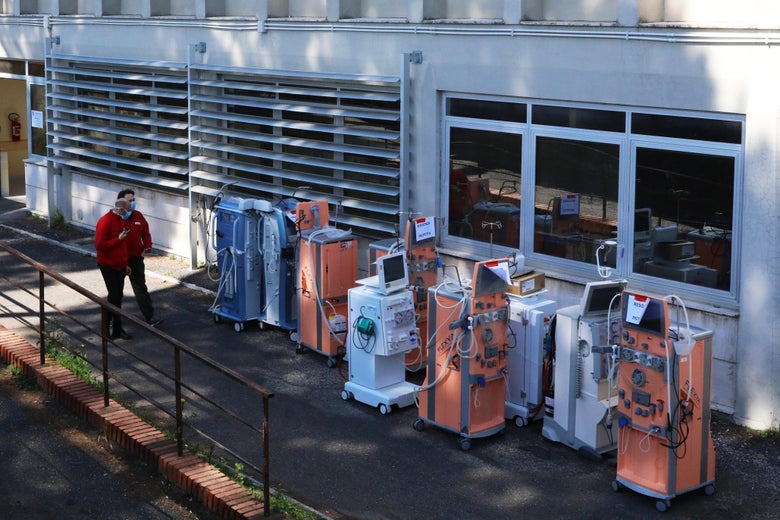
New ventilators are seen at the Columbus Covid2 Hospital on March 16, 2020 in Rome, Italy.
Marco Di Lauro/Getty Images
As COVID-19 cases continue to skyrocket, both within the United States and abroad, there is a serious chance the country will face a shortage of ventilator machines in the coming weeks. Ventilators, which often run between $25,000 to $50,000 each, are intensive care machines designed to push oxygen into the lungs of patients with acute respiratory distress. They are critical to stave off total respiratory failure, a typical cause of death for patients with COVID-19.
Per numbers from the Society of Critical Care Medicine, U.S. hospitals have a total of 160,000 ventilators–62,000 modern units immediately available and 98,000 obsolete ones that can be pulled out of storage in an emergency situation. The Centers for Disease Control and Prevention Strategic National Stockpile has an additional 13,000 ventilators, which can be accessed by request from state health officials and deployed within 36 hours. Like the CDC, states can order and maintain their own stockpiles of ventilators for emergency deployment. Yet, as American COVID-19 case numbers track just days behind those of Italy, the American Hospital Association estimates that up to 960,000 patients may need ventilatory support. Our current supply is woefully insufficient.
Given the non-answers from senior administration health officials on a potential ventilator shortage and President Trump’s comment to state governors to try “getting it yourselves,” it’s unclear how the country will respond to what seems like an inevitable shortage of the most critical piece of medical equipment needed for our nation’s most severely affected patients. But here are some options for what the federal government could do to help.
Manufacturers of ventilators, such as Medtronic and Generic Electric, can boost their production output. It’s true that this would take time and require additional investment in manufacturing capacity, but even if it takes months to boost deliveries and scale up the supply chain for ventilator parts, the government ought to be following the CDC’immediately. Hospitals, already strained with both space and personnel, might not be able to afford a surge of extra equipment that will go unused as coronavirus infections settle, but national governments can.
The German government just placed an order for 10,000 mechanical ventilators. Italy has deployed members of its armed forces to help the country’s only ventilator manufacturer meet the nation’s demand. The U.K. has called on luxury automaker Rolls-Royce to help build ventilators. ResMed, another U.S. manufacturer, is filling higher than usual orders from China and South Korea. Why isn’t the U.S. following suit?
We’ve done this kind of thing before. In 1940, during World War II, Franklin Delano Roosevelt called on America to build 50,000 combat aircraft over the next year at a time when the country had only 3,000 planes under its wing. Despite a seemingly impossible request, starting in 1941, the Ford Motor Company made one B-24 bomber per hour during the course of the war. Fifty-seven members of Congress are urging the White House to act in kind now. For war we needed planes; for pandemics we need ventilators.
The federal government could not only purchase at least 50,000 ventilators from private manufacturers, it could also offer tax credits to help them invest in new manufacturing capacity to both help existing suppliers produce up-to-date equipment for hospitals and prepare the country with a modernized stockpile for future pandemics. Further, the U.S. Food and Drug Administration should grant Emergency Use Authorization, which allows unapproved medical products to be used in an emergency, for lower-cost but equally effective ventilators to treat COVID-19 patients. COVID-19 diagnostic tools and personal protective equipment have already received this authorization, so ventilators are the logical–and necessary–next step. Subsequently, building low-cost ventilators with federal workers, akin to how Italy has redeployed its army technicians, would help emergency ventilators reach hospitals with urgent demand and avoid supply chain bottlenecks that arise when trying to import ventilator parts abroad during a crisis. For example, a student team from Harvard Medical School and the Massachusetts Institute of Technology has developed and clinically tested a low-cost breathing device that can help patients struggling to breathe at just 10 percent of the cost of traditional intensive care unit ventilators. Innovations like these can be quickly manufactured domestically and delivered to critical areas. Finally, offering hospitals funding and personnel to staff the additional ventilators and tune them to the needs of each patient will be just as crucial as the new machines themselves.
It’s impossible to predict the shape of the epidemiological pandemic curve in the U.S. and peak demand for ventilators. However, Italy’s grim, utilitarian rationing of care, in which patients who seem unlikely to survive are left without treatment, is an ethical crisis our country may be headed towards. It’s one we still have time to avoid.
Readers like you make our work possible. Help us continue to provide the reporting, commentary and criticism you won’t find anywhere else.
Join Slate Plusfrom Slate Magazine https://ift.tt/391ztdb
via IFTTT
沒有留言:
張貼留言